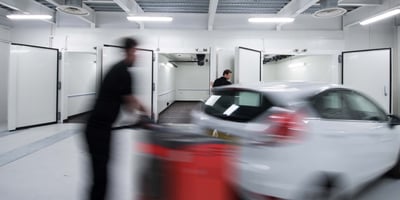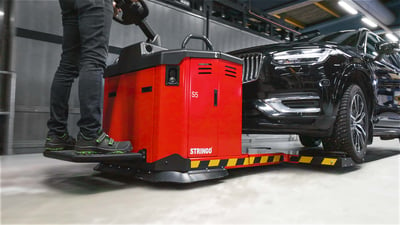In automotive production, you don’t want to waste any time moving non-starters from the end-of-line. Either you use an electric machine to move the vehicles, or you push the cars by hand. In terms of productivity, you would ask yourself: What is the difference between the two techniques? Here are all the facts you need.
Touching the car
Pushing cars by hand
If you handle cars that are sensitive to touch, pushing by hand is a risky option. Many cars these days have delicate paint jobs and sensitive car bodies with sensors, which means the pushing technique at the end-of-line can cause potential damage. If you are a private collector or own a museum, you want to protect your exclusive vehicles and not wanting anyone to touch the body of the car.
Move cars with a vehicle mover
Using a vehicle mover, you only have to touch the tires of the car. Naturally, the tires are designed to touch the ground, so you don’t have to be concerned about damaging parts that can be expensive to repair.
What is a vehicle mover? All you need to know
Efficiency at end-of-line
Pushing cars by hand
When you push a car by hand, you need multiple people. To transport a car in a production facility, you need to be at least two operators – one who steers and one who pushes from behind. If the vehicle is heavy, you probably need to be three or four people to succeed. That means two-four operators have to stop what they are doing to get the non-starter out of the way as quickly as possible. The maneuver can be time-consuming, and if your pushers aren’t fast enough, you may be forced to stop the line. However, if the pushers are well-coordinated, you will get the vehicle out of the way on time.
Move cars with a vehicle mover
A vehicle mover is a one-person operation. That means you only have to send one operator to get the non-starter out of the way when the time comes. An electric vehicle mover is easy to navigate, so you don’t have to train one or two operators as superusers – anyone can use it! Vehicle movers are designed to grip the vehicle quickly and help the operator transport cars to the repair area as fast as possible.
Navigating tight spaces
Pushing cars by hand
Pushing by hand requires space for one person to get in and out of the car. You also need some space for the pushers to move and turn while pushing the car. In tight spaces, this can become both difficult and dangerous. If there are tight spaces in your work environment, pushing by hand can be challenging. It’s harder to adjust the speed and to make sharp turns when needed. You can only use the steering wheel of the car, and you are limited to the turning radius of the vehicle.
Move cars with a vehicle mover
When you only need one person to control the vehicle's movement, you can make small adjustments and movements, which is almost impossible when you’re pushing. The main difference is that you have the car placed upon the vehicle mover. You can move as slow as you need and move in directions you wouldn’t be able to if you were pushing by hand. This allows you to make sharp turns and maneuver in very tight spaces. Your only limitation is the vehicle movers turning ratio. This means you gain more maneuverability and control of the process.
Find out the best practices to maneuver a vehicle mover
Safety
Pushing cars by hand
When there are more people involved, there’s an increased risk of damage both the car and the people near it. For one thing, there’s always a risk of doing physically challenging movements like pushing a heavy vehicle. It’s common to hurt the back, and sometimes people fall and hurt themselves trying to move a big vehicle. Then it’s the communication. If you sit behind the steering wheel, you need to communicate with the person outside the car, and this can be hard. It requires coordination between the two. If someone’s pushing while the person inside is stepping on the brake, it will come as a total surprise for the person behind the car if the communication isn’t working. If you are pushing vehicles by hand, this is a safety risk you need to take seriously. Educate your operators and talk about this to prevent critical situations.
Move cars with a vehicle mover
Using an electric vehicle mover to transport cars is the safer option – both for the employees and for the cars. The operator that navigates the machine is in full control of the situation and can easily start and stop the machine when needed. A vehicle mover grips the car gently and is equipped with safety software that can handle sudden obstacles or unexpected situations during transport. You can also use the horn of the auto mover or fit it up with a rotating warning light so that people can see that you are moving a heavy vehicle.
Learn more about the safety features of a vehicle mover in our safety Q&A





